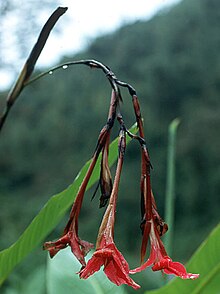Canna iridiflora
| Canna iridiflora | |
|---|---|

| |
| Scientific classification | |
| Kingdom: | Plantae |
| Clade: | Tracheophytes |
| Clade: | Angiosperms |
| Clade: | Monocots |
| Clade: | Commelinids |
| Order: | Zingiberales |
| Family: | Cannaceae |
| Genus: | Canna |
| Species: | C. iridiflora
|
| Binomial name | |
| Canna iridiflora | |
| Synonyms[1] | |
| |
Canna iridiflora is a species of herb in the family Cannaceae.[1][2]
Description
[edit]Herb up to 5 m tall. Flowers hanging down in large pendants of pink, riding above large, green leaves. Spreading stems and gently spreading leaves creates a goblet shaped clump. Plant height 5 m (16 ft). The foliage is green with pale inner edge and dark outer edge. Flowers are pendant shaped carmine-red to purple, 10–14 cm (4-5½ in) long, with a relatively long tubular part and 8 coloured lobes; petals not reflexed; staminodes 4. The solitary staminal locule (pollin-producing portion of the stamen) can be up to 5.5 inches (14 centimeters) in length,[3] equaled only by Strelitzia nicolai.
Distribution
[edit]C. iridiflora is native to Peru, Colombia and Costa Rica at altitudes of 1,800–2,850 m (5,910–9,350 ft).
Cultivation
[edit]It was introduced to England in 1816. It is hardy to zone 10 and is frost tender. In the north latitudes it is in flower from August to October, and the seeds ripen in October.
References
[edit]- ^ a b "Canna iridiflora Ruiz & Pav". Plants of the World Online. The Trustees of the Royal Botanic Gardens, Kew. n.d. Retrieved January 18, 2025.
- ^ "Canna iridiflora Ruiz & Pav". Catalogue of Life. Species 2000. n.d. Retrieved January 18, 2025.
- ^ Winkler, Hubert (1930). "Cannaceae". Pflanzenfamilien. 15A (new series) (not stated): 654.
- Cooke, Ian, 2001. The Gardener's Guide to Growing cannas, Timber Press. ISBN 0-88192-513-6
- Johnson's Gardeners Dictionary, 1856
- Tanaka, N. 2001. Taxonomic revision of the family Cannaceae in the New World and Asia. Makinoa ser. 2, 1:34–43.
